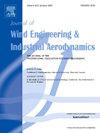沿海大跨度斜拉桥平行箱梁尾迹振动机理及减振研究
IF 4.9
2区 工程技术
Q1 ENGINEERING, CIVIL
Journal of Wind Engineering and Industrial Aerodynamics
Pub Date : 2025-08-13
DOI:10.1016/j.jweia.2025.106206
引用次数: 0
摘要
沿海大跨径平行桥由于两层甲板之间的狭窄距离和较高的风障,表现出复杂的气动干扰。在风洞试验中,对具有原始截面的并联桥梁的振动特性进行了评估,并提出了一种新的尾迹诱导振动气动对策。在此基础上,建立了平行桥流固耦合模型,分析了平行桥的流固耦合机理和缓解措施。结果表明:当迎风桥采用板条式防风屏障并在下甲板设置连续的维修轨道时,下风桥会受到显著的竖向和扭转WIV;上下甲板尾迹区产生的大规模涡周期性地在平行桥间的缝隙中脱落消散,形成谐波尾迹,诱发显著的WIV。当维修轨道位于上层甲板或间歇时,导风屏障叶片向下风桥面向下倾斜10°,可明显减小WIV振幅。向下倾斜的叶片引导气流倾斜向下,这限制了旋涡的脱落和从迎风桥尾流区域的运动。这减轻了谐波尾迹的形成,减少了下风桥的垂直和扭转WIV。本文章由计算机程序翻译,如有差异,请以英文原文为准。
Mechanism of wake-induced vibration and mitigation in parallel box girders of coastal long-span cable-stayed bridges
Coastal long-span parallel bridges exhibit complex aerodynamic interference due to the narrow distance between two decks and high wind barriers. In wind tunnel experiments, the vibration characteristics of parallel bridges with original cross-sections are evaluated, and a novel aerodynamic countermeasure is proposed to mitigate wake-induced vibrations (WIV). A fluid-structure coupling model for parallel bridges is then constructed to analyze the WIV mechanism and the mitigation measure. The results show that when the windward bridge employs slatted wind barriers and installs continuous maintenance tracks on the lower deck, the leeward bridge encounters significant vertical and torsional WIV. Large-scale vortices generated in the wake regions of the upper and lower decks periodically shed and dissipate in the slot between the parallel bridges, forming harmonic wakes that induce significant WIV. When the maintenance tracks are on the upper deck or intermittent, and the guiding wind barrier blades are tilted downward by 10° toward the leeward bridge, the WIV amplitude can be notably reduced. The downward-tilted blades direct the flow obliquely downward, which limits vortices shedding and movement from the wake region of the windward bridge. This mitigates the formation of harmonic wake, reducing the vertical and torsional WIV of the leeward bridge.
求助全文
通过发布文献求助,成功后即可免费获取论文全文。
去求助
来源期刊
CiteScore
8.90
自引率
22.90%
发文量
306
审稿时长
4.4 months
期刊介绍:
The objective of the journal is to provide a means for the publication and interchange of information, on an international basis, on all those aspects of wind engineering that are included in the activities of the International Association for Wind Engineering http://www.iawe.org/. These are: social and economic impact of wind effects; wind characteristics and structure, local wind environments, wind loads and structural response, diffusion, pollutant dispersion and matter transport, wind effects on building heat loss and ventilation, wind effects on transport systems, aerodynamic aspects of wind energy generation, and codification of wind effects.
Papers on these subjects describing full-scale measurements, wind-tunnel simulation studies, computational or theoretical methods are published, as well as papers dealing with the development of techniques and apparatus for wind engineering experiments.

 求助内容:
求助内容: 应助结果提醒方式:
应助结果提醒方式:


